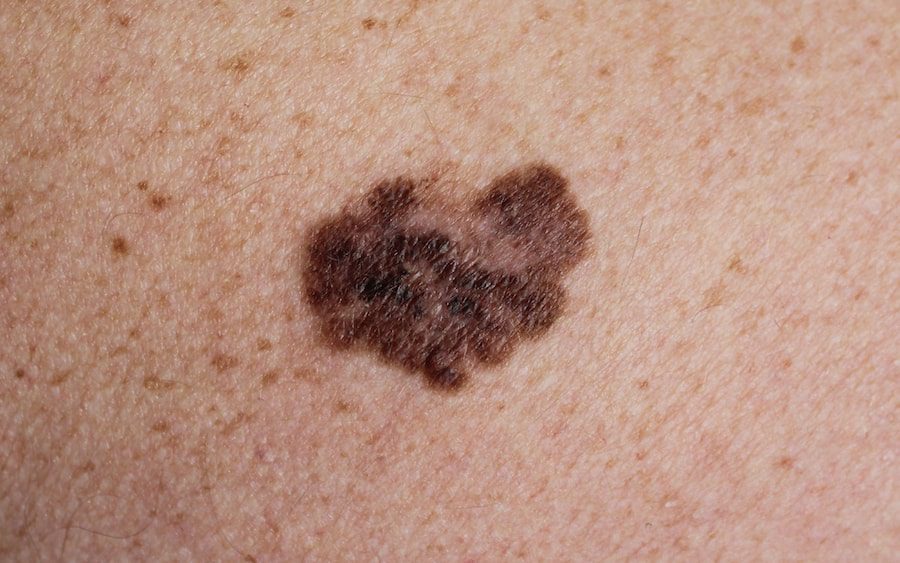Mohs Surgery | The Office of Dr. Vincent Hung
3 Minute Read:
According to the American Academy of Dermatology (AAD), nearly 9,500 Americans are diagnosed with skin cancer every day, making it the most common form of cancer in the United States.

While these statistics encompass all forms of skin cancer—including basal cell and squamous cell carcinoma—they also include melanoma, a severe form of cancer that can spread throughout the body and have serious, if not deadly, consequences.
What Is Melanoma?
Melanoma is the cancer of the melanocytes—the cells that produce melanin. Melanin is responsible for giving our skin its tan or brown color.
Every person has a different level of melanin, making some patients more susceptible to melanoma.
Even though melanoma can occur in anyone, Caucasian men over the age of 50 are thought to be at the highest risk.
What Causes Melanoma?
The most common cause of skin cancer—including melanoma—is exposure to ultraviolet (UV) rays. These rays damage your skin cells and affect the way that your melanocytes grow and divide.
But while sun damage is the primary cause, it is not the only cause of melanoma.
Additional causes include:
- Your skin type: Fair-skinned individuals are at a higher risk
- Use of tanning beds: Like natural sun damage, these beds deliver a dangerous amount of UV radiation
- Your moles: Individuals with a higher number of moles are more likely to get skin cancer.
What Are the Signs of Melanoma?
Since melanoma is often painless, it can go unnoticed if you are not vigilant. The most common sign of melanoma is a visible change to the appearance of your skin or moles.
Every person has moles on their bodies, and more often than not, these moles are harmless. A normal mole is:
- Evenly colored (brown, black, or tan)
- Round or oval
- Smaller than six millimeters
- Flat or raised (but consistent)
However, a potentially cancerous mole is:
- Shaded with various colors
- Irregular in shape
- Larger than six millimeters
- Changing in shape or color
When you are on the lookout for melanoma, consider your A.B.C.D.Es and your E.F.Gs.
- A: Asymmetry (moles that have one half that is larger than the other)
- B: Border (moles that have a ragged or uneven border and shape)
- C: Color (moles that have more than two shades)
- D: Diameter (moles that are larger than six millimeters)
- E: Evolution (new or changing moles
- E: Elevated (newly raised moles)
- F: Firm (moles that are hard to the touch)
- G: Growing (moles that are growing and changing rapidly)
Melanomas can have all of the above irregularities or only have one or two. You want to be careful and mindful of your moles.
How Is Melanoma Treated?
Melanoma is a quick-spreading cancer, and you need to act fast if you notice any irregularities in your moles or skin.
You have several treatment options for melanoma, including Mohs surgery.
Mohs surgery is a tissue-conserving method that removes cancerous cells layer by layer. While this approach eliminates the visible tumor as well as a thin rim of tissue around the cancer, it is a conservative approach that preserves more healthy tissue than traditional skin cancer treatments.
Mohs surgery not only causes less unnecessary trauma, but it also ensures the best aesthetic result. Following Mohs surgery, the area may only require the closing of the area, or it may require a skin graft.
How Is Melanoma Detected?
A melanoma diagnosis is achieved through a biopsy. This takes a sample of tissue and tests that tissue for cancerous activity.
What Can You Do to Protect Yourself?
Melanoma is very dangerous when it is not identified but very treatable when it is found early.
To ensure that you get the earliest treatment possible, perform self-skin checks every three months. During these checks, you should examine all of your moles.
Some individuals find it beneficial to make a map of their moles.
Watch out for any change in the size or look of your moles and get treatment as soon as possible, if necessary.
Are You Interested in Learning About Mohs Surgery?
If you are interested in learning more about skin cancer or Mohs Surgery in the Los Angeles or Orange County area, contact Dr. Hung by calling our Pasadena office at (626) 432-5032, our Newport Beach office at (949) 574-8292, or by filling out our online contact form.
